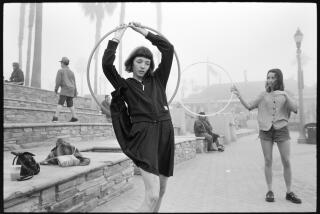JAZZ : SPOTLIGHT : Jamming With the Camera : William Claxton--the photographer of choice for jazz musicians since the ‘50s--brings verve and vitality to a new book and exhibition of his work.
- Share via
‘For the photographer,” says William Claxton, “the camera is like a jazz musician’s ax. It’s the tool that you would like to be able to ignore, but you have to have it to convey your thoughts and whatever you want to express through it.”
Few photographers have communicated and expressed their thoughts about jazz through their photographs better than Claxton, who has been the visual chronicler of choice for musicians since the ‘50s. Starting out when he was a college student from Pasadena, the tall, lanky young man was a regular at every jazz club he could talk his way into, initially lugging a cumbersome Speed Graphic, and eventually producing some of the most memorable images ever recorded of jazz in action.
This week, Claxton’s newest collection, “Claxography: The Art of Jazz Photography” (Niesvand Velag) will be published.
“It’s not really my title,” he says with a slightly embarrassed chuckle [in an interview where? via fone?]. “A jazz musician named Dan St. Marseille wrote a tune for me--a bebop tune--and came up with the title. I was a little worried, at first, that it might seem like kind of an egotistical choice for a book title, but I had to come up with something in a hurry. So, I thought, OK, I’ll just call it ‘Claxography.’ And now it seems like the right choice.”
The pictures in “Claxography,” striking examples of Claxton’s ability to capture his subjects in moments of revelatory clarity, range from 1952 to the present. The oldest photograph is of trumpeter Harry “Sweets” Edison and bassist Oscar Pettiford. The most recent include shots of Wallace Roney, Jon Faddis, Benny Green and Wynton Marsalis.
A thoughtful assemblage of Claxton’s work can be seen in an exhibition, also titled “Claxography,” which runs through Feb. 17 at the Fahey/Klein Gallery. For the jazz fan, the pictures--especially the earlier ones--resonate with associations. Almost as much as the recordings themselves, the photographs reach into the essence of making music.
“That’s where jazz and photography have always come together for me,” Claxton says. “They’re alike in their improvisation and their spontaneousness. They happen at the same moment that you’re hearing something and you’re seeing something, and you record it and it’s frozen forever.”
Claxton continues to be an active force in jazz photography. Among other assignments, album covers for Roy Hargrove, Christian McBride, Mark Isham and Nicholas Payton are in the works, as well as a Herb Alpert album [if a cover, why not list with others in previous clause? and a fashion spread featuring jazz singers Holly Cole and Kurt Elling. And the long-delayed American publication of “Young Chet,” Claxton’s superb photo journal of trumpeter Chet Baker’s youthful, James Dean-like years, is scheduled for this year, coincident with a Blue Note compilation of previously unheard Baker recordings from the ‘50s.
But Claxton, in his mid-60s, retains the jazzman’s essential desire to reach for more spontaneity, to get past the instrument and into the pure expression of the creative act.
“There’s no getting around it,” he says, “it’s like I said before. The camera really is like a musician’s horn, and a necessary impediment. Sometimes I wish I could shoot pictures without a camera totally--just trip them from my brain, and they’d be better than anything I can do with a camera.”
*
“Claxography: The Art of Jazz Photography,” Niesvand Velag, $60. “William Claxton: Claxography,” Fahey/Klein Gallery, 148 N. La Brea Ave. Through Feb. 17. (213) 934-2250.


